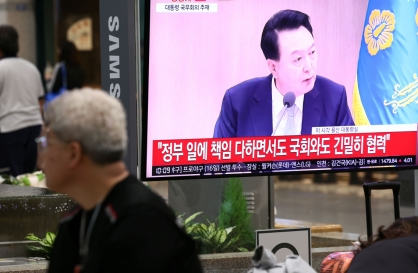China-India energy rivalry in spotlight as Modi visits Nepal
By Korea HeraldPublished : Aug. 3, 2014 - 20:54
KATHMANDU (AFP) ― Energy will be high on the agenda when India’s new Prime Minister Narendra Modi visits Nepal on Sunday, eager to claw back lost ground in the race for resources with China.
A vast network of fast-flowing rivers through the Himalayas leaves huge untapped hydropower resources at Nepal’s disposal, and New Delhi has spent years encouraging Indian investment with an eye on the country’s water resources.
However, proposals to develop joint ventures between India and Nepal have stalled due to disagreements over perceived threats to Nepalese sovereignty, allowing rival China to step into the breach.
A recently leaked draft plan to develop the hydropower sector using Indian investment sparked a furore in Kathmandu, with politicians and commentators saying it would grant New Delhi exclusive rights to Nepal’s water resources.
“Nepalese politicians want India to pay attention to them, but they are also fearful that given a chance, it will take over their resources, being a bigger, more powerful country,” said Lok Raj Baral, former ambassador to New Delhi.
India has traditionally exerted huge influence in Kathmandu, leaving many in Nepal wary of New Delhi and eager to embrace Beijing, whose investment they do not see as politically motivated, Baral said.
Stalled Indian projects include a hydropower agreement to develop Nepal‘s Karnali river signed by Kathmandu and Indian infrastructure giant GMR in 2008.
Meanwhile, Beijing is funding a 60-megawatt power plant on the Trishuli river, already under construction, and a $1.6 billion, 750-megawatt joint venture on the Seti river, due to be completed by December 2019.
“Despite geographic proximity, cultural intimacy, economic interdependence and shared political values, India has stumbled in Nepal,” wrote C. Raja Mohan, columnist for the Indian Express.
Citing a growing perception in Nepal that “India promises, China delivers,” he wrote that “India’s record of project implementation in Nepal is awful.”
But India’s new government has made clear its desire to refocus attention on its near neighbours. Modi’s visit to Nepal follows a June trip to Bhutan, where he announced a new hydropower plant.
Nepal‘s Prime Minister Sushil Koirala said this weekend that hydropower cooperation would be a priority in his talks with Modi and he expected a “breakthrough.”
“I am determined to push ahead on this agenda ... I am convinced that in 8-10 years, Nepal can take a great leap,” he told India’s Hindustan Times daily.
Nepal‘s total installed power generation capacity is now just 750 megawatts -- less than two percent of its potential.
That is insufficient even to meet Nepal’s own energy needs, forcing the country to endure power cuts of up to 12 hours a day and purchase fuel from India, itself an importer of petroleum products.
In addition to the proposed 900-megawatt joint venture on the Karnali river, Indian infrastructure company GMR also owns an 82 percent stake in a 600-megawatt project on the Marsyangdi river, which is expected to be completed in 2021.
According to GMR, 12 percent of the power generated by the Karnali project will be given to Kathmandu free of cost, with the remainder exported to India.
Once the company has recouped its investment, it will transfer ownership of both projects to Nepal‘s government.
While India has sought to develop other energy sources at home and in the region, striking deals with Thimphu and Dhaka, Beijing has made forays into Sri Lanka and Nepal, leaving New Delhi anxious over the contest for resources.
Sujeev Shakya, author of “Unleashing Nepal”, told AFP: “It’s time for India to let go of its Sinophobia.”
“It makes more sense for Delhi and Beijing to work together -- whether it‘s a case of using Indian investment and Chinese turbines to build hydropower plants or transmitting electricity from Nepal to China via Calcutta or even installing a regional grid,” Shakya said.
A focus on cooperation rather than competition would give a bigger boost to trade and enable greater regional growth, he said.
“Growth in India and China will benefit the whole region -- of course the smaller countries can play them off against each other, but given the size of both markets, it’s smarter to exploit synergies between them.”
The change in India‘s leadership has opened a new window for regional engagement, Shakya said.
“The more India and China engage with neighbours, including each other, the better it is for regional connectivity. This is not a time for anyone to be myopic.”
A vast network of fast-flowing rivers through the Himalayas leaves huge untapped hydropower resources at Nepal’s disposal, and New Delhi has spent years encouraging Indian investment with an eye on the country’s water resources.
However, proposals to develop joint ventures between India and Nepal have stalled due to disagreements over perceived threats to Nepalese sovereignty, allowing rival China to step into the breach.
A recently leaked draft plan to develop the hydropower sector using Indian investment sparked a furore in Kathmandu, with politicians and commentators saying it would grant New Delhi exclusive rights to Nepal’s water resources.
“Nepalese politicians want India to pay attention to them, but they are also fearful that given a chance, it will take over their resources, being a bigger, more powerful country,” said Lok Raj Baral, former ambassador to New Delhi.
India has traditionally exerted huge influence in Kathmandu, leaving many in Nepal wary of New Delhi and eager to embrace Beijing, whose investment they do not see as politically motivated, Baral said.
Stalled Indian projects include a hydropower agreement to develop Nepal‘s Karnali river signed by Kathmandu and Indian infrastructure giant GMR in 2008.
Meanwhile, Beijing is funding a 60-megawatt power plant on the Trishuli river, already under construction, and a $1.6 billion, 750-megawatt joint venture on the Seti river, due to be completed by December 2019.
“Despite geographic proximity, cultural intimacy, economic interdependence and shared political values, India has stumbled in Nepal,” wrote C. Raja Mohan, columnist for the Indian Express.
Citing a growing perception in Nepal that “India promises, China delivers,” he wrote that “India’s record of project implementation in Nepal is awful.”
But India’s new government has made clear its desire to refocus attention on its near neighbours. Modi’s visit to Nepal follows a June trip to Bhutan, where he announced a new hydropower plant.
Nepal‘s Prime Minister Sushil Koirala said this weekend that hydropower cooperation would be a priority in his talks with Modi and he expected a “breakthrough.”
“I am determined to push ahead on this agenda ... I am convinced that in 8-10 years, Nepal can take a great leap,” he told India’s Hindustan Times daily.
Nepal‘s total installed power generation capacity is now just 750 megawatts -- less than two percent of its potential.
That is insufficient even to meet Nepal’s own energy needs, forcing the country to endure power cuts of up to 12 hours a day and purchase fuel from India, itself an importer of petroleum products.
In addition to the proposed 900-megawatt joint venture on the Karnali river, Indian infrastructure company GMR also owns an 82 percent stake in a 600-megawatt project on the Marsyangdi river, which is expected to be completed in 2021.
According to GMR, 12 percent of the power generated by the Karnali project will be given to Kathmandu free of cost, with the remainder exported to India.
Once the company has recouped its investment, it will transfer ownership of both projects to Nepal‘s government.
While India has sought to develop other energy sources at home and in the region, striking deals with Thimphu and Dhaka, Beijing has made forays into Sri Lanka and Nepal, leaving New Delhi anxious over the contest for resources.
Sujeev Shakya, author of “Unleashing Nepal”, told AFP: “It’s time for India to let go of its Sinophobia.”
“It makes more sense for Delhi and Beijing to work together -- whether it‘s a case of using Indian investment and Chinese turbines to build hydropower plants or transmitting electricity from Nepal to China via Calcutta or even installing a regional grid,” Shakya said.
A focus on cooperation rather than competition would give a bigger boost to trade and enable greater regional growth, he said.
“Growth in India and China will benefit the whole region -- of course the smaller countries can play them off against each other, but given the size of both markets, it’s smarter to exploit synergies between them.”
The change in India‘s leadership has opened a new window for regional engagement, Shakya said.
“The more India and China engage with neighbours, including each other, the better it is for regional connectivity. This is not a time for anyone to be myopic.”
-
Articles by Korea Herald






![[From the Scene] Monks, Buddhists hail return of remains of Buddhas](http://res.heraldm.com/phpwas/restmb_idxmake.php?idx=644&simg=/content/image/2024/04/19/20240419050617_0.jpg&u=20240419175937)








![[From the Scene] Monks, Buddhists hail return of remains of Buddhas](http://res.heraldm.com/phpwas/restmb_idxmake.php?idx=652&simg=/content/image/2024/04/19/20240419050617_0.jpg&u=20240419175937)

![[KH Explains] Hyundai's full hybrid edge to pay off amid slow transition to pure EVs](http://res.heraldm.com/phpwas/restmb_idxmake.php?idx=652&simg=/content/image/2024/04/18/20240418050645_0.jpg&u=20240419100350)

![[Today’s K-pop] Illit drops debut single remix](http://res.heraldm.com/phpwas/restmb_idxmake.php?idx=642&simg=/content/image/2024/04/19/20240419050612_0.jpg&u=)